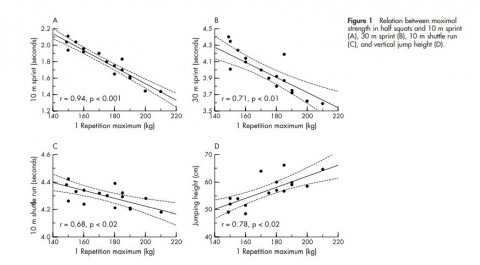Sprinting and vertical jump performance are important skills in the game of soccer. In terms of sprinting, a soccer player will sprint every 90 s during a match. These sprints average about 2-4 seconds and can account for up to 11% of the distance covered during a match. And with vertical jump performance think of all the times a player will go up for a header, off a corner or as a keeper exploding up to deflect a ball over the cross bar. So while intuitively it makes sense that sprinting and jumping are important in soccer it would be beneficial to know how important they are. And from a strength and conditioning perspective, how important is a strength exercise like the back squat, to improving these qualities? A group of researchers looked to answer these questions and called upon a Norwegian pro soccer club to participate in the study. 17 male soccer players from Rosenborg FC, average age 25 years, were put through a number of performance tests to see how what the relationship was between the 1 RM half squat with sprinting and jumping. Rosenborg FC is a top flight team in Norway having won their league a number of times and participating in the Champions League. For the 1 RM back half squat players did barbell back squats to 90 degrees of knee flexion, adding load until a 1 RM was determined. Once they were warmed up, most players took three to six sets to determine their 1 RM. For the sprint test, players ran from 0-30 m with photocell timing gates. Splits were recorded at each 10 m and the players rested 5 minutes between the two attempts. The best sprint time was included in the data presented. And for the vertical jump a force platform was...
Built for Show - And for Go
- Chris Collins
- Fitness
- 2059 Hits
- 0 Comments
-
There seems to be a school of thought when it comes to resistance training that you're either training for performance or for aesthetics. It's either bodybuilding or strength and conditiong. Built for show or for go. It was as though the two goals were mutually exclusive and could not overlap. Meatheads would mock those who couldn't build 20 inch arms. And athletes would point out all the gym rats that trip over their own feet during a game of football. But is that the case? If you train for hypertrophy i.e. size, does that mean you'll be useless on the playing field? New research says that's not the case. The study look at muscle volume and strength and compared this among three groups 1) elite sprinters n= 5, 2) sub-elite sprinters n= 26, and untrained controls n=11. All study subjects were male. Elite sprinters were defined as though that could run a 10.10 second 100 meter and sub-elite as though that could run the 100 m in 10.80 seconds. To put in perspective how fast a 10.10 second 100 metre is, only four Canadians have ever run a sub 10 second 100 m including Olympic champion Donovan Bailey and Olympic bronze medallist Andre De Grasse. The study subjects underwent MRIs to determine muscle volume of 23 lower limb muscles and 5 functional muscles. These were then correlated to 100 m times and isometric strength. What they found was that the muscularity of elite sprinters was greater in elite sprinters than sub-elite and both were greater than the controls. In particular the hip extensors showed the biggest difference among the groups and this accounted for 31-48% of the variability in 100 m times. Of the hip extensors it turns out the gluteus maximus alone accounted for 34-44 % of variance in 100...
Go Hard or Go Frequently?
- Chris Collins
- Fitness
- 1776 Hits
- 0 Comments
-
The other night at dinner we asked our five year old the question of which came first, the chicken or the egg? She thought about it briefly and then answered confidently saying the egg. To which we then asked her where the egg came from? You can imagine the puzzled look on her face and could see the wheels turning in her head. She realized she it was going to be a hard question to answer. This can be similar to exercise with respect to whether you should do long, slow steady-state exercise or short, high intensity intervals. The last few years have seen a surge in HIIT i.e. high intensity interval training, Tabata and other intense training protocols. However during COVID we have also seen a number of endurance feats including Everesting, round the world cycling challenges and other long distance endurance challenges. So which one is it? Should we go hard and short or long and slow? Well a recent Canadian study looked to answer this question. Here's what they did. Twenty three adult, sedentary men were divided into two groups. One group did 30 second sprint intervals on the bike with two minutes rest. They repeated this four to six times and completed this workout three times per week. Over the course of the six study they completed almost one hour of cycling. The other group rode the bike five times per week for 30-40 minutes at around 60% of their peak power. By the completion of the study this group had logged 15 hours on the bike. Researchers wanted to know the impact these would have on fitness, body composition and blood pressure. What they found is that those performing the endurance workouts i.e. 30-40 minutes of cycling saw greater improvements in: diastolic blood pressureabdominal fatpostprandial lipid...
How Hills Can Make You Faster
- Chris Collins
- Fitness
- 2006 Hits
- 0 Comments
-
Do you watch Fargo? I'm not talking about the movie, which was pretty good, but instead I'm referring to the TV show. We're just getting into it and it's awesome. But a word of warning to those with small children or that are squeamish...there's some killing and bloodshed. In fact the only thing that probably kills more than Billy Bob Thornton's character is speed. [caption id="attachment_5317" align="aligncenter" width="206"] Only speed kills more than Billy Bob Thornton's character on Fargo. That's the truth. In sports, speed kills. And for team sport athletes there are a number of things we can do to improve our speed. One thing I really like to incorporate into training to help with speed is to run some hills. Why Run Hills? Hills can be a great tool to help us get faster because it encourages proper foot contact. Imagine bounding up a fill as though jumping from one foot to the next. This doesn't really work we if land on the heel and try roll through the foot. If we used a heel-toe roll strategy we would lose all the momentum generated by bounding from one leg to the next. And we would slow right down. https://youtu.be/p2bYUE2roX4 The other great thing about running hills is the increased need for the arm action. The arms will help with propulsion and balance. Sometimes we'll see athletes start to move but not using their arms initially. In this case they are not as fast or explosive as they could be. Due to the inclination of the hill the arms become more of a necessity to assist with propulsion and to help us maintain balance as we jump from foot to foot. This can become more apparent when running downhill. Larger arm swings from the shoulder will help keep the arms...


